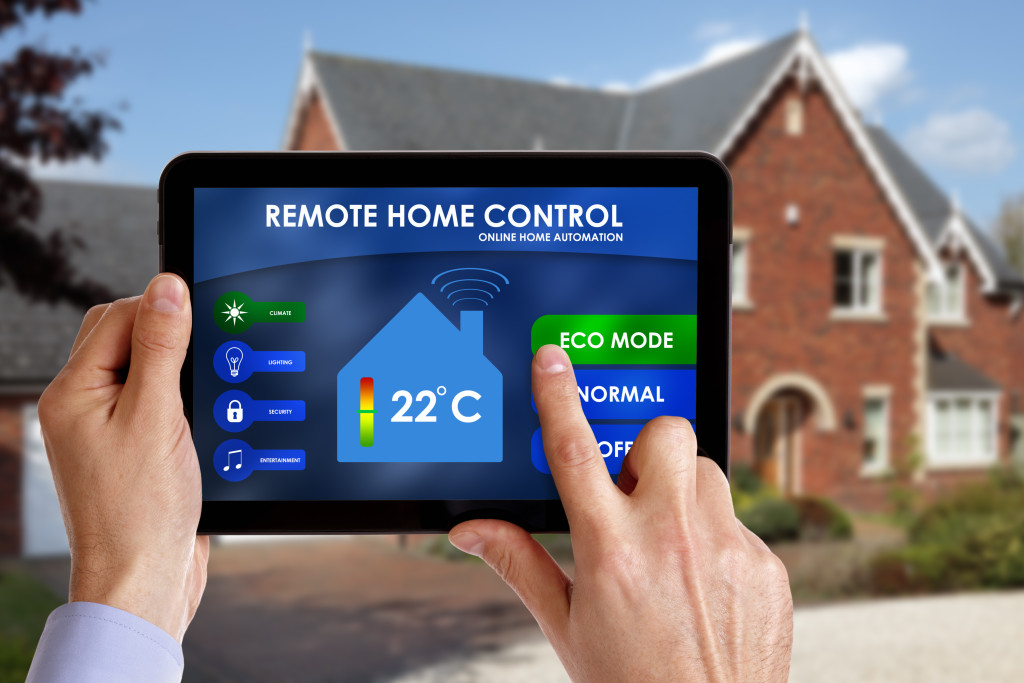- Automated energy efficiency helps reduce energy waste and the cost of utilities.
- Smart water conservation technologies can monitor your usage levels, alert for leaks and adjust the water flow to prevent over-watering.
- Air quality control systems regulate temperature, humidity levels and pollutants in the home.
- Sustainable home designs incorporate renewable energy sources and smart building materials for increased comfort and value.
- Smart waste management devices help track waste generation and allow for composting of food scraps or collection of rainwater.
Smart home technology has revolutionized how society interacts with their homes, providing greater convenience and comfort to homeowners. But did you know that it can also help the environment? Smart home technology can reduce energy consumption and pollution, making your home more sustainable. Here are five ways that your smart home technology can help the environment.
1. Automated Energy Efficiency
Smart home devices make tracking and adjusting energy use in real-time easy. Your thermostat learns your family’s habits and preferences, so it can automatically set temperatures when you’re away or asleep. Modern lighting systems detect when someone enters a room and turn off lights when they leave—saving energy and money on utility bills. And intelligent power strips can detect when devices are not in use and shut off their power, reducing energy waste.
Here are some additional benefits of innovative home energy efficiency:
Remote Access or Control
Many smart home devices can be remotely controlled with your smartphone or voice command—so you can adjust temperatures and lighting even when you’re away from home. This helps minimize energy consumption, create a more comfortable environment, and save money on utility bills. Consider utilizing systems like the top-rated Honeywell pro series security system with surveillance, alarms, thermostats and lighting control all in one app. App-controlled security systems also aid in curtailing energy consumption by automatically setting lighting schedules and arming your home when you are away.
2. Water Conservation

Smart home technology also helps your family conserve water by monitoring usage levels and alerting you to any leaks. Modern irrigation systems can also adjust water flow based on the current weather conditions, helping reduce water waste from over-watering. If you’re looking for a simpler way to save some H2O, innovative shower heads will automatically shut off after a certain amount of time or usage level is reached—allowing you to take shorter showers without remembering to turn them off.
3. Air Quality Control
From air purifiers and filters to air quality monitors that notify you about pollutants in your home, various modern home tools can help improve air quality. Innovative vents allow you to regulate the temperature in each room better, so you don’t have to overwork your HVAC system. And by controlling indoor humidity levels, you can prevent allergens like mold from growing and spreading throughout your home.
4. Sustainable Home Design
Smart home technology allows homeowners to design their homes with sustainability in mind. With connected products such as solar panels and battery storage systems, homeowners can generate their renewable energy and store it for future use. Smart tech windows let you control the amount of natural light coming into your home—reducing the need for artificial lighting during the day and helping save energy. And with intelligent building materials, such as low-VOC paints and recycled glass countertops, you can create a sustainable home without sacrificing style.
Lower Energy Bills
By opting for sustainable home designs, you can drastically reduce your energy bills—saving both money and energy in the long run. Smart windows adjust to the season, allowing you to keep out the heat during summer months and trap it in during winter months—so you don’t have to overwork your air conditioning system or heater.
Increased Comfort

Sustainable home designs also provide greater comfort for homeowners since they are designed with efficiency in mind. Windows that let in natural light create a more open environment and help regulate temperatures better than traditional windows. And innovative building materials like low-VOC paints improve indoor air quality, keeping your family healthier overall.
Increased Home Value
Companies that appraise homes often consider sustainable features when evaluating a property, meaning that having a sustainable home may increase its value in the long run. Smart windows are especially attractive to potential buyers since they improve insulation and energy efficiency, making them more desirable than traditional windows. So if you’re considering selling your home in the future, you may increase its value by making it more eco-friendly.
5. Smart Waste Management
Smart waste management technology makes it easy to reduce, reuse, and recycle more efficiently. For example, smart trash cans alert you when the trash needs to be emptied, and help track how much waste your family generates—so that you can adjust your practices accordingly. You can also install connected composters to turn food scraps into soil for garden use or install rainwater collectors to reduce the need for tap water in specific tasks like watering plants.
In Summary
Incorporating these five strategies into your household’s routine can positively impact the environment. Smart home technology simplifies energy efficiency and sustainability initiatives, saving you money while helping the planet. As this technology continues to evolve, staying up-to-date on the latest developments is crucial to make your home as eco-friendly as possible. With innovative home technology, you can quickly reduce your carbon footprint and help create a more sustainable world for future generations. So get started today and see how your new smart home devices can help protect the environment.
